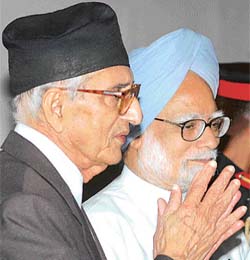 Prime Minister Girija Prasad Koirala’s hastily arranged visit to India has raised deep suspicions among Nepalis, traditionally wary of the motives of their giant southern neighbor.
Prime Minister Girija Prasad Koirala’s hastily arranged visit to India has raised deep suspicions among Nepalis, traditionally wary of the motives of their giant southern neighbor.The fact that Indian Prime Minister Manmohan Singh broke protocol and went to the airport to receive Koirala doesn’t seem to have mattered much. New Delhi’s promise of a Himalayan Marshall Plan doesn’t seem to have impressed too many Nepalis.
Now don’t get Maila Baje wrong. He hasn’t lost any of his congenital mistrust of official India’s motives just because New Delhi has chosen to equate Koirala with President George W. Bush. Prime Ministers Jawahar Lal Nehru and Indira Gandhi, after all, used to meet with King Mahendra at the airport whenever the late monarch was in transit in New Delhi. Where did that land the Panchayat system?
Maintaining eternal vigilance as the price of liberty is hard enough in ordinary times. The changes of 1950 and 1990, brought about through India’s active involvement, changed Nepal’s political landscape. Or so we thought. In retrospect, they ended up serving India’s interests – especially in terms of concessions on Nepal’s vast water resources – more than ours. Otherwise, five constitutions later, we still wouldn’t be fighting over where sovereignty really resides and who really controls the army.
For all his reincarnation as the savior of Nepalese democracy, Koirala’s allies in the Seven Party Alliance (SPA) still see in him the halo of having “sold out” Nepal’s interests in the early 1990s by signing the Tanakpur Treaty with India and then misrepresenting it for months as a mere understanding to avoid parliament. To be fair, Koirala’s successors – Manmohan Adhikary and Sher Bahadur Deuba, in particular -- were hardly above reproach on this count.
Those who refuse to learn from history are condemned to repeat it -- individually and collectively, Santayana might have added. Leaders of SPA constituents sought specific assurances from the premier that he would not sign any controversial deal. That insurance policy should be instantly cashable if the premier, in his age-induced infirmity, happened to walk into another minefield.
Admittedly, it’s pointless to argue here that India would definitely want to extract its pound of flesh – to put it crudely – from the latest change in Nepal’s body politic. India’s foreign policy, like that of any country, is an extension of its domestic policy.
Amid the all-round preponderance of India, the most Nepalis can do is remain watchful. It’s troubling, however, to hear some of our political and civil-society watchdogs bark from both sides of their mouths.
Subodh Pyakurel, who heads the Informal Sector Service Center, maintains the legal status of the restored parliament is unclear. “It was revived by the king at the last moment and immediately accepted by the Seven-Party Alliance,” he was quoted as saying by an Indian daily. Dina Nath Sharma, a member of the Maoist delegation to the peace talks with the Koirala government, was more categorical: “The current government does not have the mandate to take decisions on nationally important issues.”
Here’s the real question: If the SPA government and the reinstated legislature are good enough to turn Hindu Nepal into a secular state, to create a republic in all but name even before delimiting the constituencies for the constituent assembly that’s supposed to determine the fate of the monarchy, and to rewrite citizenship laws, why can’t Prime Minister Koirala exercise his full responsibilities in the area of foreign affairs. Or does the “historic mandate” of the April Uprising end at Nepal’s southern border?